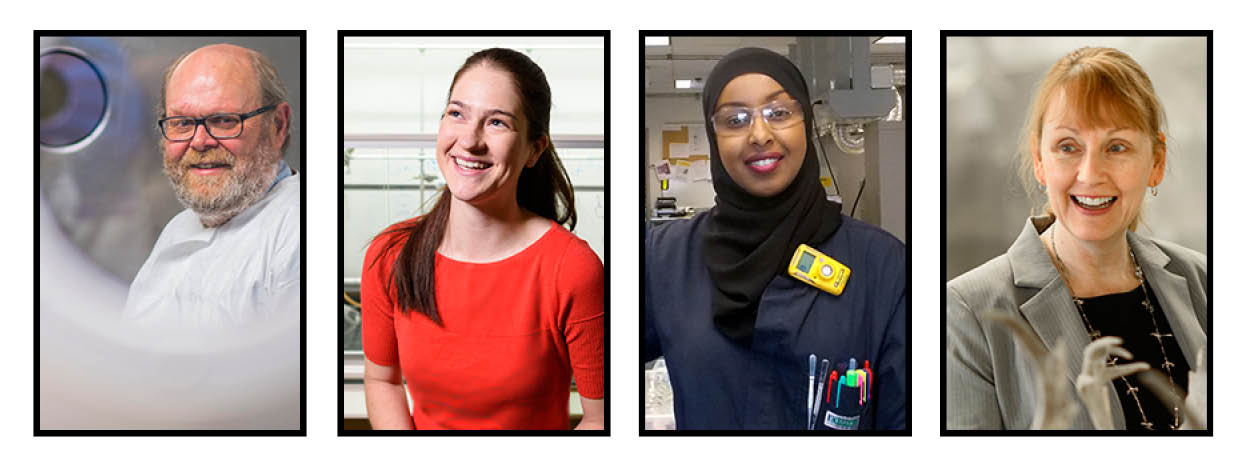
To some, it is known as discovery or fundamental research. To others, it is basic or foundational research. From fundamental to foundational researchers, there is a sense of collective optimism in the scientific community surrounding the recent federal government attention given to science funding at the most basic level, throwing some weight behind discovery research in its March budget.
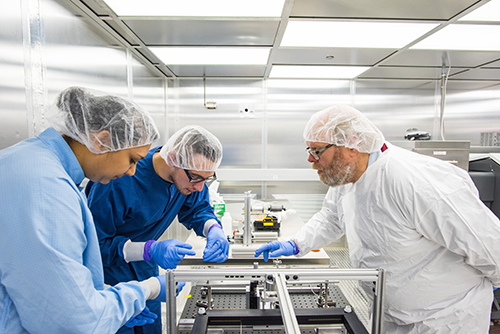
Aksel Hallin (right) and students Pooja Woosaree (left) and Thomas MacElroy working in the Low Radon Cleanroom, building a device to measure trace levels of natural radioactivity in various components. The facility provides a clean atmosphere which has less than one per cent of the radon in normal room air.
The new Liberal government has sent a clear message, earmarking an additional $95 million annually to granting councils-the highest amount in more than a decade-for a total of $141 million in new annual resources going forward. While it could take years for the impact of this investment to be realized, scientists have renewed support for fundamental and large-scale discoveries that require additional resources-and maybe a leap of faith.
Aksel Hallin has seen firsthand how a commitment to consistent funding for basic research can lead to world-changing discoveries. A physics professor and Canada Research Chair in Astroparticle Physics at the U of A, Hallin was part of the team that worked with Art McDonald ('11 DSc) at the Sudbury Neutrino Observatory (SNO). Their research led to the discovery of neutrino oscillations, demonstrating that neutrinos have mass, and earned McDonald the 2015 Nobel Prize in Physics.
"Our universities should be working on the big problems in human knowledge. Many of those problems are in fundamental science, and many of the answers can lead to profound changes in the way we think." -Aksel Hallin
"The Nobel Prize and the Breakthrough Prize [also awarded to McDonald] were international recognition that Canadian science made the right decision in pursuing underground physics," comments Hallin. "It recognizes that our research is competitive at the highest level and at the cutting edge."
Physicists predicted that three per cent of the energy of the sun should come in the form of neutrinos. They observed that it was actually one per cent and questioned the missing two per cent. "That mystery existed from the 1970s until the SNO experiment ran," says Hallin. "We knew there had to be a result that would either dramatically change our understanding of the way stars worked-the sun is our typical star-or we were going to understand neutrinos. We had a great experiment."
Hallin points to the fact that this knowledge-of quantum mechanics, the structure of matter, electromagnetism, and nuclear forces-has been central to the radical technological changes that have completely changed our way of life, adding that Canada still has some work to do in terms of developing a coherent approach to funding science.
"To design, build, and use our type of experiment requires capital infrastructure funds, operating funds, research funds, and personnel," explains Hallin. "Although the distinction between these might seem academic, from the perspective of a scientist, the funding programs to which one applies are completely different and often don't coordinate."
While only time will tell the extent of funding coordination, Canadian post-secondary institutions can look to a commitment to attracting and retaining world-class researchers-both established and rising stars-as support for building internationally competitive teams to solve those big research questions.
"To push these knowledge frontiers in basic science we have to push the frontiers of technology as well, and an interdisciplinary approach is essential for success. I think the support for both basic and applied science is very important." -Art Mcdonald, Canada's 2015 Nobel Prize Winner in Physics
Support for fundamental science makes good chemistry
Following the law of attraction, rising science star and recent Faculty of Science hire Florence Williams (chemistry) was drawn to the U of A from the U.S. by not only the collegiality and personality of the department but also for the unparalleled infrastructure in place to support her research.
"My area of focus bridges organic chemistry and chemical biology. Whenever you bridge two disciplines," explains Williams, "you often find that you need more equipment and facilities than a typical lab. The University of Alberta has support labs of various types already in place and run by exceptionally trained staff."
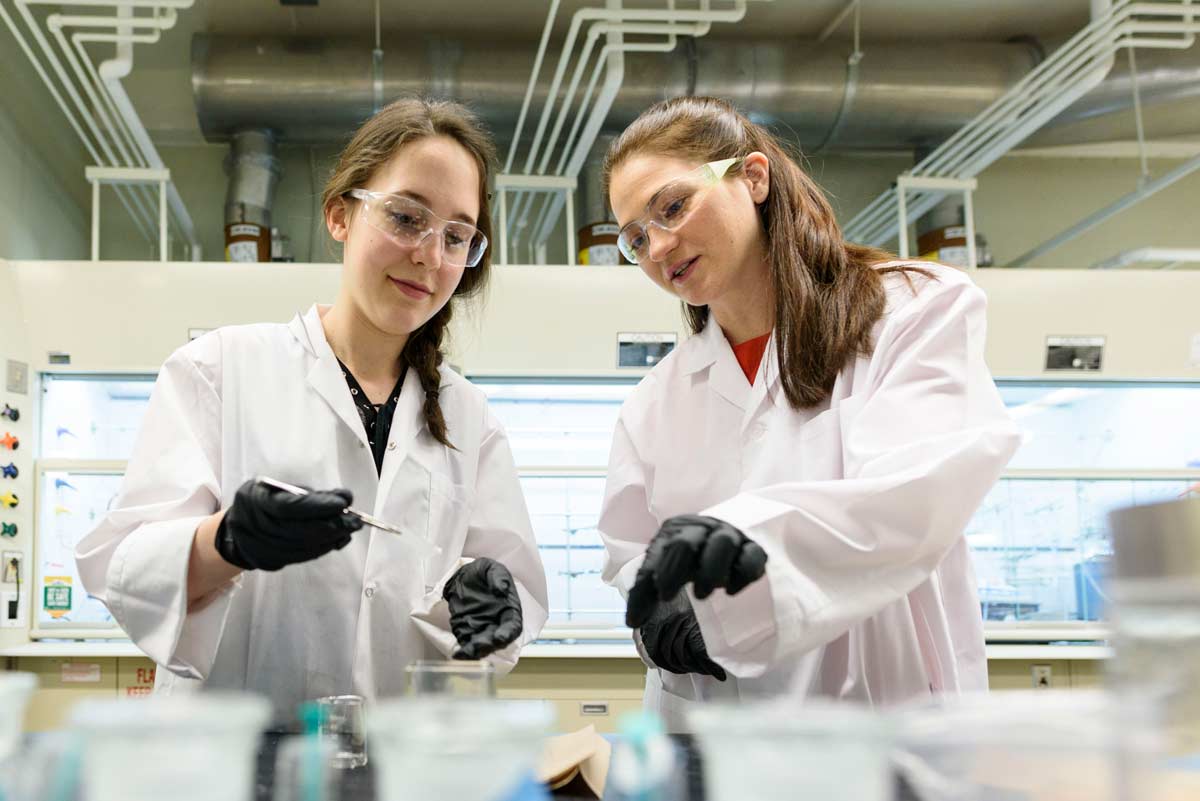
Florence Williams (right) pictured with undergraduate student Daniela Hernandez.
Williams came fresh off a post-doc at Princeton where her most successful project was the development of a fluorescent compound which shifts its fluorescent light emission when it interacts with a diphosphate ester. These diphosphate esters are considered a new type of post-translational modification of proteins in the cell. "We think that the cell adds this group onto proteins to change their behavior in response to certain conditions that the cell experiences," she explains. "It is a way to react to a changing environment."

Canada's Minister of Science expresses her excitement on the day of the funding announcement.
However, many questioned whether this process did indeed occur. Scientists needed a new way to show that the diphosphate ester existed on a natural protein isolated away from the cell, and Williams' reagent is helping to do that.
Now that she has settled in at the U of A, Williams will focus her research attention to a collection of naturally produced small molecules, considered neurotrophic. Neurotrophic describes anything which causes neuronal cells to behave as though they were exposed to proteins called neurotrophins, the body's natural way to signal neuron cells to grow and to resist death.
"I love the academic environment, which is so focused on scientific discussion and creativity. To be able to pursue my own scientific ideas and at the same time help others to appreciate and understand chemistry is a phenomenal privilege." -Florence Williams
"Neurotrophic responses are of interest in relation to Alzheimer's, Parkinson's, and Huntington's diseases, as well as brain/spinal cord trauma or stroke, because all of these disorders cause neuronal cell death," she explains. "There is almost nothing known about how these small molecules cause the desired neurotrophic effects. I would like to make small modifications of these molecules in such a way that they can tell me what they interact with and how they trigger a change in the neuron."
With recent funding from the Canada Foundation for Innovation's (CFI) John R. Evans Leaders Fund, Williams also plans to explore new ways to study processes that occur in the cell, specifically looking to develop new reactions that can be used in living cells to investigate fundamental changes in response to different external changes or internal signals.
"I love the academic environment, which is so focused on scientific discussion and creativity. To be able to pursue my own scientific ideas and at the same time help others to appreciate and understand chemistry is a phenomenal privilege."
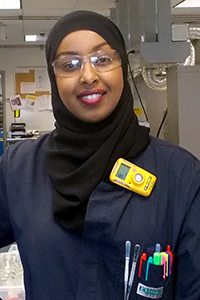 Fundamental training sets foundation for success
Fundamental training sets foundation for success
For recent graduate Yasmin Barre (BSc '09, MSc '12), her fundamental research training at the U of A applies daily to her work as an Associate Laboratory Technologist with the product quality team at Shell Canada in Fort Saskatchewan.
Barre developed an interest for understanding and examining host-pathogen interactions while working in the lab of UAlberta microbiologist Christine Szymanksi (biological sciences). "The projects run in Dr. Szymanski's lab were quite interdisciplinary," remembers Barre. "This allowed for collaboration with other groups as well as access to analytical technologies, such as HR-MAS (High Resolution Magic Angle Spinning) NMR (Nuclear Magnetic Resonance), mass spectrometry, affinity chromatography, proteomics and microarrays, and protein expression profiling. There was a vast array of techniques and skills I learned during my studies in the Szymanski lab."
"Working in a lab feels very natural for me," says Barre. "My research skills developed from my graduate program provided me with the critical thinking and judgement I need for method development, writing standard operating procedures, and improving current analytical procedure by saving time and reducing waste and cost."
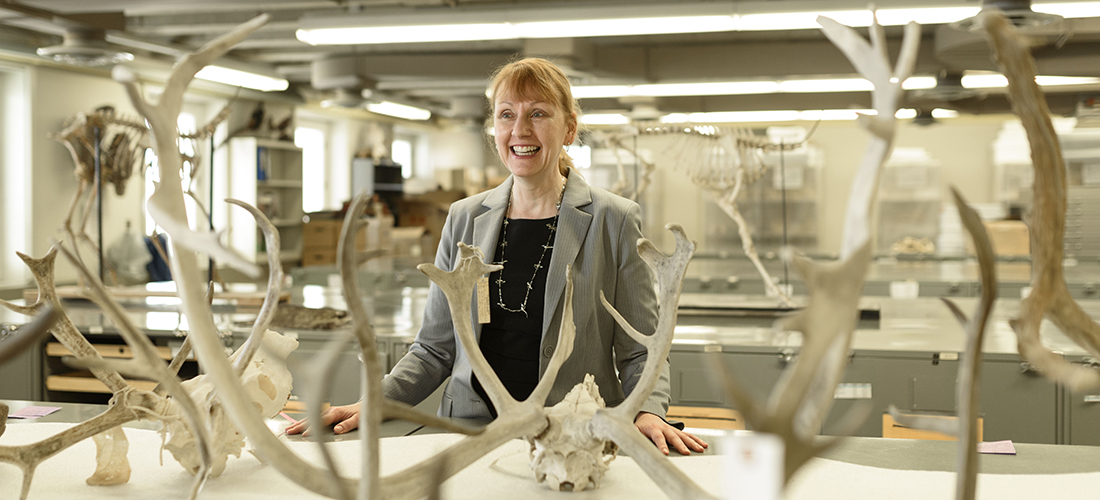
Suzanne MacDonald draws daily from her background in zoology and genetics for her work as an animal behaviourist.
Applying natural skills in nature
Like Barre, Suzanne MacDonald ('84 BSc, '86 MSc, '89 PhD) draws on her basic science training in her role as an animal behaviourist, working with animal populations around the world to better understand their behaviour and the impact of human activity on wildlife.
MacDonald started as an undergraduate at the U of A studying zoology and genetics, following that up with graduate work in psychology. The combination of basic science plus psych gives MacDonald a unique perspective of how animals view a situation, often providing a different way of approaching a problem.
"Making basic science accessible to everyone, especially young people, and doing research that will benefit communities in Canada and around the world is what we're here for." -Suzanne MacDonald
She studies a range of species, from those in the wild-gorillas, cheetahs, tigers, and elephants-to urban environments-think raccoons-to pandas and orangutans in zoos.
MacDonald has worked extensively with the Toronto Zoo, where she has volunteered as a behaviourist for the past 20 years (and no, she did not get to hold the baby pandas). "We record animal behaviour over an extended time period and then compare that to what we expect it to be like in the wild," she explains. "If the animals are well adjusted, they should show a wide range of behaviours, including courtship and mating. If not, we can try to modify their environment to see if we can help them adjust to their surroundings."
Similar principles apply in the wild. In Kenya and South Africa, MacDonald and her team are helping to mitigate human-elephant conflict. One solution implemented at the Lewa Wildlife Conservancy in Kenya was to build a corridor that allows elephants to safely go up and down the mountain on their annual migration path. The challenge was how to get the elephants to actually use the corridor, rather than their usual route through farms. Knowing that 40 per cent of an elephant's brain is olfactory lobe, MacDonald decided to try using scent as a way to attract them to the corridor. Based on knowledge gained in captivity that elephants liked vanilla, she tried this in the wild, and it worked.
MacDonald is a firm believer in sharing her knowledge with communities in order to improve our human-animal interactions. "The public funds our universities, and I feel that it is vital to share our results-and our enthusiasm for research-with our supporters. Making basic science accessible to everyone, especially young people, and doing research that will benefit communities in Canada and around the world is what we're here for."